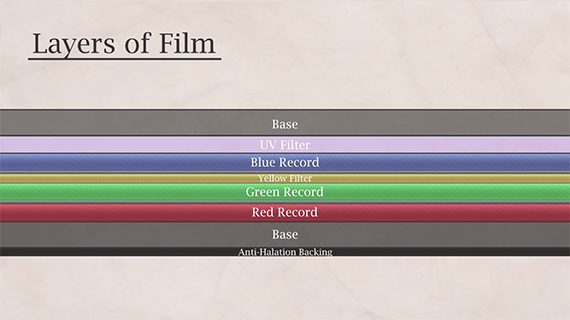Film has been around for well over a century. It’s by far the most used medium in terms of the length of time it has been in use and the sheer volume of relevant and well-known images that have been shot with it. And I’m not even considering the Hollywood blockbusters. Though the modern world has since moved on to digital, film still lingers on. It’s still being used by connoisseurs—both still photographers and filmmakers—who refuse to quit on film. This video by What Is . . . is a breezy run through of what film is and how it has been instrumental in capturing some of the most well-known images in human history:
Perforations
One of the most easily distinguishable marks on a strip of film are the perforations that run along the edges of its entire length.

Perforations on Film
These are instrumental in helping the camera to move the film while the images are being made.

Strips for Recording Audio
Some film even has a strip that allows audio to be recorded, which is either magnetic or optical. When recording motion pictures, however, audio is recorded onto a separate audio recording device.
Frames
The larger rectangles inside the strip are the frames and these are where the optical magic happens, meaning, this is where your images are recorded. There are various frame sizes. The larger the frame size, the larger the potential projection that can be made out of it before the image quality gets degraded. The common frame sizes are 8mm, Super 8mm, 16mm, Super 16mm, the extremely popular 35mm, and the super-sized IMAX standard 70mm.

Common Film Sizes
Layers of Film
The film itself is a stack of layers that consists of light sensitive emulsions, filters, and barriers. But the most important of them is probably the layer that consists of tiny light sensitive grains of silver halide.

Layers of Film
When they receive light, they are sensitized. We call it being exposed. During film development, a chemical bath removes the grains that have been thus sensitized. So, the more the grains are exposed in a particular area, the more grains that are removed during development (consequently, the whiter that area becomes). This is basically how black and white film works.

Light Sensitive Silver Halide Layer
For color film, there’s not one but three different light sensitive layers. Each of these layers on a strip of color film gets sensitized when exposed to light of a particular color. These colors are blue, green, and red—in that order. Information in these three layers is composited to produce one color image.

Color Film
Film Base
These light sensitive layers, filters, and barriers are sandwiched together into a transparent material to produce what is known as the film stock. In the early days of photography this sandwiched material was based on Nitrocellulose. It was slightly difficult to work with because of its, well, explosive nature. Nitrocellulose was actually used in early military explosives. Cellulose Acetate later replaced Nitrocellulose as the preferred material for use. Finally, in the 1990s, Polyester plastic replaced Nitrocellulose to be the dominant base for film stock. It’s since been used in an almost unchanged format.
And there you have it. A quick explanation of film. Have you ever shot film?
Like This Article?
Don't Miss The Next One!
Join over 100,000 photographers of all experience levels who receive our free photography tips and articles to stay current:






thanks for all this information, This will help me on my project on 16mm Film!
I not only used to shoot 20-30 rolls a year (maybe a dozen of those at fair time, in standard 35, half-frame, and panoramic), but I’ve actually threaded 35mm projectors (and untangled film jams, and spliced them back together after cutting the burned/wrinkled film out). Annoying thing is, I got into photography just a tad bit to late to learn developing. Our college had a darkroom, but nobody had time to teach me.